Mikania (Mikania micrantha) is a tropical vine which is native to the Americas. Often referred to as the ‘Mile-a-Minute Weed,’ mikania grows rapidly in areas of high rainfall and has become highly invasive in parts of Asia and the Pacific. Under the Convention on Biological Diversity, invasive species are defined as alien species that threaten native ecosystems, habitats or species and in Nepal, mikania and other invasive plants such as chromolaena (Chromolaena odorata) are becoming increasingly problematic within the Chitwan National Park (CNP). There, the plants are having a serious negative impact on native grasses, shrubs and the one-horned rhinoceros, and by implication, deer and tiger populations. They are also affecting the local people who reside in the buffer zones and rely on the park for fodder and other materials.

A rhino amongst chromolaena
Rhinos
In a specific study on mikania, scientists from the National Trust for Nature Conservation, Nepal with support from CABI and the Zoological Society of London have found a significant negative relationship between high mikania coverage and the population of rhinos. This is because the mikania vine smothers the fodder plants that the rhinos feed on. This could also be influencing their movement to other areas of the park where they feed on resources and crops important to local people. This in turn may exacerbate conflict between the residents of the buffer zones and the wildlife in the area.
Deer and Tigers
The reduction in fodder plants is likely also to cause a mirrored decrease in the number of deer in the park. Deer feed on similar plants to the rhinos and the impact of mikania on native vegetation is therefore likely to affect their feeding behaviour in a comparable manner. As a result a decrease in deer numbers is likely to have a negative impact on tiger populations, with tiger numbers being directly related to the populations of their prey.
Local people
The residents of the buffer zones surrounding the CNP are known to rely on the core area of the park for resources such as fodder, which they use to feed their livestock. These residents recognise that fodder availability within the park has decreased and report that collecting materials now takes three times as long as it has in previous years to gather the same amount of fodder. Reduced fodder has been attributed to flooding of the park and the spread of invasive plant species. In particular, a high proportion of local residents report that mikania has a significant negative impact on the fodder growing in the park.
Sustainable control of mikania weed
CABI piloted using a rust fungus (Puccinia spegazzinii) as a classical biological control agent for mikania weed in India. This highly host specific and damaging pathogen has now been released in Papua New Guinea and Taiwan, where it is having a significant impact on the growth of the weed. The rust has recently been released on a number of other Pacific Islands, and could be considered for release in Nepal.
1 Comment
Leave a Reply
Related News & Blogs
Training on mass production of entomopathogenic nematodes for biological control of invasive insect pests
A team of global experts in the production of biocontrol agent provided a practical training on the mass culture of entomopathogenic nematodes at the Biocontrol Agent Facility of Rwanda Agriculture and Animal Resource Development Board (RAB), writes Dr…
20 December 2023





Nice blog about chitwan national park. Thanks for introducing me the wonder of Rhino, Crocodile, Deers elephants , Peacocks and many more. An Amazing national park